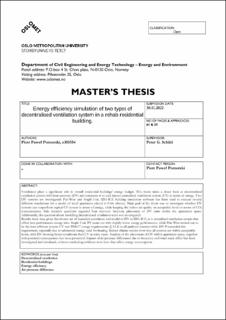| dc.description.abstract | Ventilation plays a significant role in overall residential buildings’ energy budget. This thesis takes a closer look at decentralised ventilation system with heat recovery (DV) and compares it to well-known centralised ventilation system (CV) in terms of energy. Two DV systems are investigated: Pair-Wise and Single-Unit. IDA-ICE building simulation software has been used to execute several different simulations for a model of small apartment placed in Oslo climate. Main goal of the thesis was to investigate whether DV systems can outperform typical CV system in terms of energy, while keeping the indoor air quality on acceptable levels in terms of CO₂ concentrations. Side research questions regarded heat recovery function, placement of DV units within the apartment space. Additionally, the question about modelling decentralised ventilation units was investigated.
Results show that, given the chosen set of boundary conditions and model of DV in IDA-ICE, it is centralised ventilation system that offers best performance energy wise. Single-Unit DV came out with slightly worse energy performance, while Pair-Wise turned out to be the least efficient system. CV met TEK17 energy requirements (§ 14-2) in all analysed scenario while DV-P exceeded this requirement, especially due to substantial energy used for heating. Indoor climate results show that all systems are within acceptable levels, with DV showing better conditions then CV in some cases. Analysis of the placement of DV within apartment space, together with potential consequences has been presented. Impact of air pressure differences due to buoyancy and wind-stack effect has been investigated and simulated, without concluding evidence as to how they affect energy consumption. | en_US |
